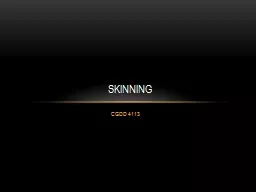

Skinning What is SKINNING The process of binding a skeleton to a mesh M ethods Parent binding Requires models to be separate Individual mesh is parented to individual bone Rigid binding ID: 403522
Download Presentation The PPT/PDF document "CGDD 4113" is the property of its rightful owner. Permission is granted to download and print the materials on this web site for personal, non-commercial use only, and to display it on your personal computer provided you do not modify the materials and that you retain all copyright notices contained in the materials. By downloading content from our website, you accept the terms of this agreement.
Slide1
CGDD 4113
SkinningSlide2
What is SKINNING?
The process of binding a skeleton to a mesh
M
ethods:
Parent binding
Requires models to be separate
Individual mesh is “parented” to individual bone
Rigid binding
Vertices closer to a bone will follow that bone
Lattice binding
Create a lattice deformer, rigid bind the lattice to the bones
Smooth binding
A vertex or CV can be influenced by multiple bonesSlide3
Parenting
Each cylinder to each bone
Test via rotationsSlide4
Rigid Binding
Two skeletons, one NURB and one poly – each subdivided 10
Skin->Bind Skin->Rigid BindSlide5
Effects of Bending
Polys are made of vertices
NURBS are defined by CVsSlide6
Membership
Edit Deformers->Edit Membership ToolSlide7
Flexors
Type of deformer to prevent cracking
Useful for polygons
Without Flexor
With FlexorSlide8
Set Driven Keys
Can set keys for the flexor in various positions
Animate->Set Driven Key->Set
The middle joint’s Y rotation will “drive” the points of the flexor lattice
Note: When the book says “Zero the rotation”, just clear them in the channel boxSlide9
Lattice Binding
Create a lattice deformer for the polygon
Rigid bind the
root joint
to the lattice
Finish by changing the ffd1 node (local influences) to 4
Gives a much smoother appearance
Easier to edit membership! Lattice CVs vs. vertices
Can also use Driven Keys to define a bulge for the bicepSlide10
Smooth Binding
Skin->Bind Skin->Smooth Bind
Sweet == trueSlide11
Weight Painting
Not covered
in this book
Something good
to look into
“Paint” how much
a bone will
influence verticesSlide12
Getting back to our Character…
Start by setting the preferred angle (RMB on the pelvis joint)
Select only joints that should affect the mesh
Best done in the
Outliner
view
Use Smooth Binding!
Wireframe turns purple
Smooth bind the eyeballsSlide13Slide14
Rigid Binding
Eyes (to eye joints), eyelids (to head joint) and collar (to neck)Slide15
Weight Painting
Try bending the
shoulder…
Experiment with
weight painting!
ProblemsSlide16
Joint Degrees of Freedom and Limits
A way of restricting how the joint moves
Found in the Attribute editor